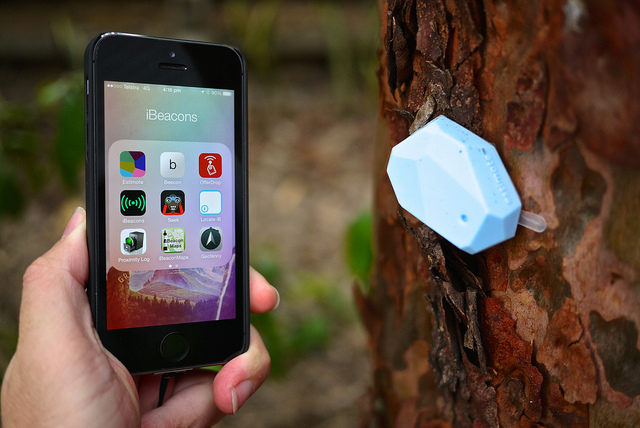Consumers have an intimate relationship with smartphones—we rely on them for everything from communication to research, productivity to shopping and hours of heads-down entertainment to avoid human contact.
Newzoo forecasts 2.6 billion people in the world will have a smartphone this year, with China and India alone accounting for more than one billion users. To connect with these consumers, more and more brands are turning to beacons—proximity marketing—that beam information directly to a mobile app once within range.
What Are Beacons?
Unlike the GPS-or-FourSquare-using Pokémon GO—which uses its own proprietary system—beacons are small, Bluetooth radio transmitters that emit specific information once a device (like a smartphone) is nearby. Mobile apps designed to recognize the specific beacon signals then relay that information to the user and this technology works especially well for detecting consumers inside buildings.
IBeacon is Apple’s technology standard, which allows mobile apps (running on both iOS and Android devices) to listen for signals from beacons in the physical world, and react accordingly. When a consumer using a discount shopping app, for example, approaches a beacon inside a department store, they may receive push notifications offering exclusive deals or provide additional information about a product.
Who Uses Beacons?
Right now, beacons are everywhere. In fact, Android devices pull more than 40 billion queries for beacon-related content from Google services every year. More than four million beacons are already installed in retail locations, and last year proximity marketers Proxbook predicted that at least a million more would be installed in the US alone. Major retailers currently using beacons include Rite Aid, Barnes & Noble, Macy’s and Target.
 “We just see a great upside in using beacons to enrich the one-to-one experience with our customers,” said Gerard Babitts, Rite Aid’s senior director of digital marketing, during a panel at Toshiba’s Retail Innovation & Shopper Expertise Symposium (RISE), per GeoMarketing. “And if they’re in our stores, our customers don’t browse: they are very purposeful about what they want. The dwell time isn’t that great and it’s not the point. When someone is in our store, we want to make it as great an experience as possible, which means getting them directly what they want as quickly as possible. Beacons can help us do that.”
“We just see a great upside in using beacons to enrich the one-to-one experience with our customers,” said Gerard Babitts, Rite Aid’s senior director of digital marketing, during a panel at Toshiba’s Retail Innovation & Shopper Expertise Symposium (RISE), per GeoMarketing. “And if they’re in our stores, our customers don’t browse: they are very purposeful about what they want. The dwell time isn’t that great and it’s not the point. When someone is in our store, we want to make it as great an experience as possible, which means getting them directly what they want as quickly as possible. Beacons can help us do that.”
Measurable Data
Every marketer knows that without data, appealing to consumers and measuring a campaign’s success would be a mystery. One of the great benefits to using proximity marketing through beacons is measurable data. Either a consumer interacts with the beacon or they don’t, eliminating guess work.
To promote the company’s partnership with the James Bond film Spectre, Heineken used beacons that communicated with apps like Checkpoints that raised awareness and verified when consumers were inside a retail location. The campaign through inMarket produced 200,000 in-store and point-of-sale engagements and an estimated $320,000 in direct revenue.
Swirl, a proximity marketing platform, found that over the holiday season last year, mall-based specialty retailers saw a 41 percent increase in average basket size, and a 36 percent increase in mall-to-store traffic conversion rates.
Thinking Outside Retail
Beyond working well in a retail environment, proximity marketing provides valuable information to consumers. Bluetooth Facebook beacons allow visitors to learn more about a local business on the social network, prompting them to “like” and check-in, view or make recommendations and more.
Thirty-five percent of the top 20 American airports have deployed beacons offering information to travelers, such as in-flight entertainment, navigation and shopping experiences.
For the game Battlekasters, Artifact Technologies uses Bluetooth beacons strategically placed around fan conventions. Users search for certain locations to collect cards, set traps and be the first to achieve an objective.
The Nearby function on Android devices uses beacons to recommend helpful apps based on location. For example, users can access an audio tour while at The Broad museum in Los Angeles, print photos from a phone at a nearby CVS pharmacy or access free in-flight entertainment before boarding United Airlines.
Whether you call it geomarketing, proximity marketing or just plain “beacons,” the industry is worth an estimated $40 billion, according to Proxbook, and it will continue to grow as long as consumers seek instant information about the worlds around them.
